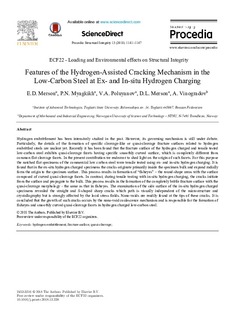| dc.contributor.author | Merson, E. D. | |
| dc.contributor.author | Myagkikh, P. N. | |
| dc.contributor.author | Poluyanov, V. A. | |
| dc.contributor.author | Merson, D. L. | |
| dc.contributor.author | Vinogradov, Alexey | |
| dc.date.accessioned | 2019-03-04T12:08:08Z | |
| dc.date.available | 2019-03-04T12:08:08Z | |
| dc.date.created | 2019-01-10T13:58:51Z | |
| dc.date.issued | 2018 | |
| dc.identifier.citation | Procedia Structural Engineering. 2018, 13 1141-1147. | nb_NO |
| dc.identifier.issn | 2452-3216 | |
| dc.identifier.uri | http://hdl.handle.net/11250/2588465 | |
| dc.description.abstract | Hydrogen embrittlement has been intensively studied in the past. However, its governing mechanism is still under debate. Particularly, the details of the formation of specific cleavage-like or quasi-cleavage fracture surfaces related to hydrogen embrittled steels are unclear yet. Recently it has been found that the fracture surface of the hydrogen charged and tensile tested low-carbon steel exhibits quasi-cleavage facets having specific smoothly curved surface, which is completely different from common flat cleavage facets. In the present contribution we endeavor to shed light on the origin of such facets. For this purpose the notched flat specimens of the commercial low carbon steel were tensile tested using ex- and in-situ hydrogen charging. It is found that in the ex-situ hydrogen charged specimens the cracks originate primarily inside the specimen bulk and expand radially form the origin to the specimen surface. This process results in formation of “fisheyes” – the round-shape areas with the surface composed of curved quasi-cleavage facets. In contrast, during tensile testing with in-situ hydrogen charging, the cracks initiate from the surface and propagate to the bulk. This process results in the formation of the completely brittle fracture surface with the quasi-cleavage morphology - the same as that in fisheyes. The examination of the side surface of the in-situ hydrogen charged specimens revealed the straight and S-shaped sharp cracks which path is visually independent of the microstructure and crystallography but is strongly affected by the local stress fields. Nano-voids are readily found at the tips of these cracks. It is concluded that the growth of such cracks occurs by the nano-void coalescence mechanism and is responsible for the formation of fisheyes and smoothly curved quasi-cleavage facets in hydrogen charged low-carbon steel. | nb_NO |
| dc.language.iso | eng | nb_NO |
| dc.publisher | Elsevier | nb_NO |
| dc.rights | Attribution-NonCommercial-NoDerivatives 4.0 Internasjonal | * |
| dc.rights.uri | http://creativecommons.org/licenses/by-nc-nd/4.0/deed.no | * |
| dc.title | Features of the Hydrogen-Assisted Cracking Mechanism in the Low-Carbon Steel during Ex- and In-situ Hydrogen Charging | nb_NO |
| dc.type | Journal article | nb_NO |
| dc.description.version | publishedVersion | nb_NO |
| dc.source.pagenumber | 1141-1147 | nb_NO |
| dc.source.volume | 13 | nb_NO |
| dc.source.journal | Procedia Structural Engineering | nb_NO |
| dc.identifier.doi | 10.1016/j.prostr.2018.12.238 | |
| dc.identifier.cristin | 1654196 | |
| dc.description.localcode | © 2018 The Author(s). Published by Elsevier B.V. CC-BY-NC-ND 4.0 license http://creativecommons.org/licenses/by-nc-nd/4.0/ | nb_NO |
| cristin.unitcode | 194,64,92,0 | |
| cristin.unitname | Institutt for maskinteknikk og produksjon | |
| cristin.ispublished | true | |
| cristin.fulltext | original | |

